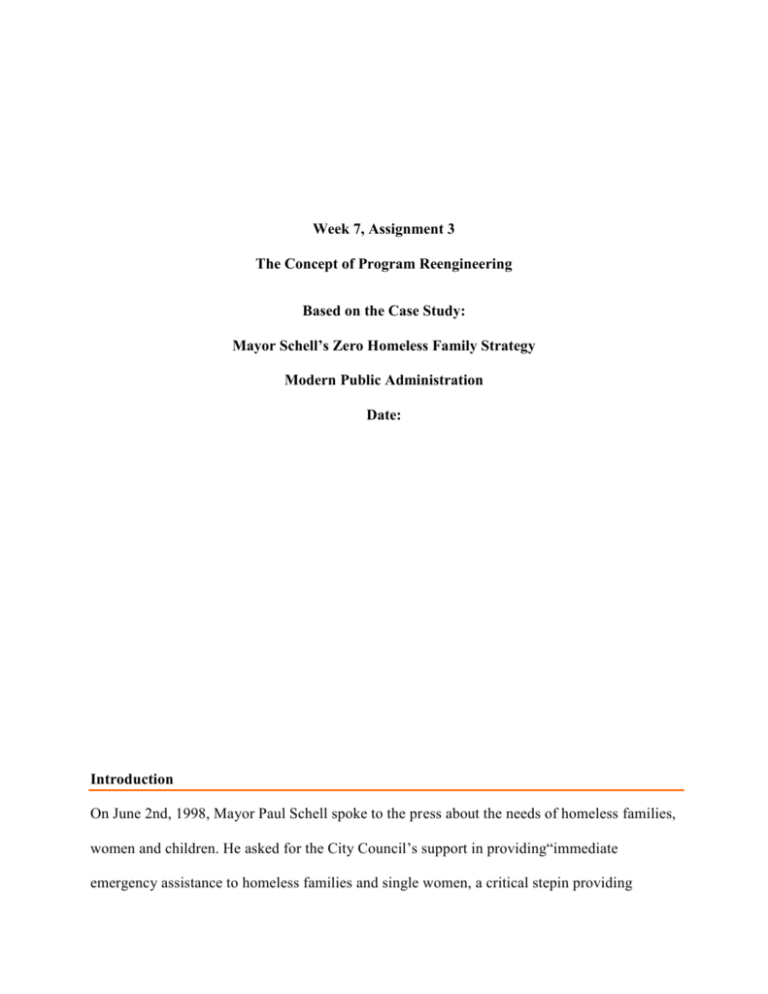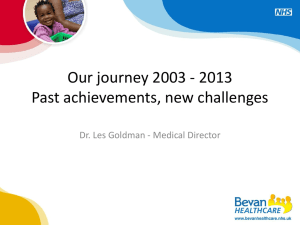ExamTutorials PAD 500 Assignment 3 the Concept
advertisement

Week 7, Assignment 3 The Concept of Program Reengineering Based on the Case Study: Mayor Schell’s Zero Homeless Family Strategy Modern Public Administration Date: Introduction On June 2nd, 1998, Mayor Paul Schell spoke to the press about the needs of homeless families, women and children. He asked for the City Council’s support in providing“immediate emergency assistance to homeless families and single women, a critical stepin providing lasting housing solutions for these families and individuals.” He noted that“the problem continues to grow and we absolutely must find better ways to help peoplefind and keep housing.” He closed his remarks with a firm pledge that there will be nohomeless families with children or homeless single women on the streets of Seattle byChristmas 1998. His pledge made headlines in both Seattle papers the next day. Alan Painter, Director of the Community Services Division of the Department ofHousing and Human Services, listened attentively to the new Mayor’s remarks. Painterhas dedicated his professional career to serving the needs of homeless people. He wasproud and excited to hear Schell’s passion and commitment to addressing homelessnessin Seattle. At the same time, he viewed the pledge with some trepidation. Counting thenumber of homeless people on the street at any given time is notoriously tricky,influenced by many factors. Further, he wondered how this pledge would dovetail withCity priorities and plans for dealing with homelessness. These plans emphasize servicesto homeless people rather than just providing beds and they stress the need for otherjurisdictions to share in funding homeless services. The next six months promised to keepAlan Painter very busy. This assignment is about Mayor Paul Schell’s pledge for homeless families in Seattle, Washington. Mayor Schell on June 2, 1998 spoke to the press and pledge that there will be no homeless families with children and homeless single women on the streets of Seattle by Christmas 1998. This assignment will analyze the policies, strategies, and programs within his administration and the impact on them by his pledge. It will also study the implementation of the program. In addition, it will discuss the importance of the assessments prior to the implementation. Analyze four (4) policy choices of Mayor Schell that were made as part of the strategy for the homeless. Mayor Paul Schell has several options to make to create a strategy about the homeless situation in Seattle. In the city the county committee had created its own strategy to attend the homeless condition. Even though, the county program has been in place for several years already their focus is in continuing supportingthe existent shelters and services provided to the homeless, not to expand the capacity of them. Based on that, four policy choices Mayor Schell could had made as part of his strategy for the homeless are: 1) Convene a housing summit – “Schell promised to convene a housing summit immediately after his inauguration to develop strategies to address the unmet demand for affordable housing” (Hallway, 2010, p.5). The lack of affordable housing is one of the main reasons for the increasing numbers of homeless people in Seattle. Attacking the source of the problem is an assertive way to solve the problem. 2) Create more shelters or housing options for the homeless – the existent strategies of the King County Community Homelessness Advisory Committee did not provide for the expansion of the services. “These plans emphasize services to homeless people rather than just providing beds” (Hallway, 2010, p.1). Therefore an immediate plan needed to be put in place. 3) Support and expand the housing programs for homeless and people in need – the homeless population was affected by different factors. “The three major factors contributing to homelessness in King County are inadequate income, the high cost of housing, and personal or family problems, such as domestic violence, drug and alcohol abuse or mental illness” (Hallway, 2010, p.2). For that reason the continuous support to the programs that provide services to them, or even the expansion of these services at certain point needs to be considered as part of the solution. 4) Keep strengthening the support programs for transitional housing families – After these families and individuals are brought to the transitional housing programs the right support and guideline could make the difference between succeeding and keeping a permanent housing, or going back to the streets. As mayor Schell expressed “a critical step in providing lasting housing solutions for these families and individuals” (Hallway, 2010, p.1). Providing lasting housing, not only provisional housing should be the goal. Analyze the Pre-Implementation and Design Strategies of Mayor Schell and interpret four (4) practical outcomes of his choices. Mayor Schell pre-implementation and design strategies are intimately related to the policy choices previously mentioned. His strategy is to decrease the number of homeless in the streets of Seattle before the Christmas 1998. He mentioned more specifically, homeless families with children and single women. He also stated his interest on designing a strategy to develop more affordable housing for those in need. As part of the implementation more capacity in the shelters or more shelters needed to be created and best support for the programs that provide services and immediate assistance to the homeless population. As possible outcomes from these strategies four (4) practical outcomes that could be mention are: 1) Successfully achievement of the goal – meaning that actually by Christmas 1998 all families with children and single women will be out of the streets of Seattle and in a temporary housing arrangement (shelter, transitional housing, etc.). 2) Re-design of the city programs – as result of the new strategy the county programs will be adjusted to serve the new goals of providing more capacity, and readjusted to provide services to the new individuals as the preexisting ones. 3) New housing programs – one of the first things Mayor Schell stated was his interest in facilitating more affordable housing. As a result of this strategy new housing programs could emerge as part of the effort. 4) Re-adjustment of the final goal – it is always a possibility that initial plan could not be achieved. From June to December it is only six months of difference. The city budget would need to be adjusted for the new necessities, and probably new funding would be necessary. These and other factors could affect the chances of success of the program. Reconstruct four (4) steps taken by Mayor Schell to reengineer the program in order to fit the new objectives. The day after Mayor Schell communicated his pledge both Seattle newspaper dedicated its headlines to the new. According to Susan Byrnes (1998), “The mayor said … he would ask the City Council to immediately allocate $500,000 for additional shelter beds, short-term rent assistance to families about to be evicted and hotel vouchers for homeless women and children. Schell also released a list of 11 ways ordinary citizens can help address homelessness, including respecting and being kind to them” (The Seattle Times, para.2). Through this declaration the four (4) steps taken by Mayor Schell to reengineer the program are easy to identify. 1) Convocation of the housing summit – to be able to immediately allocate $500,000 for the program the Mayor needed to summit all the components involved in this planning process. From the County committee, city staff, and any private organization related with the program. 2) Building new shelters - identifying the most viable and more economically manageable options, it was possibly one the first steps done by Mayor Schell and the committee in charge. 3) Re-strengthening the support programs for homeless - supporting programs like short-term rent assistance to families about to be evicted, hotel vouchers for homeless women and children and low income housing was another step taken by the Mayor. 4) Involve the community and organizations – acknowledging the community of the need of them be part of the solution could be really helpful and make a change in the final outcome. In addition, appealing to organizations, from non for profit organizations to private organizations, which their services and products will contribute and add to the realization of the main goal, is a well needed step in the search for more opportunities for the homeless population. Analyze four (4) reasons for the importance of conducting assessments prior to new program implementation. Four (4) reasons for the importance of conducting assessments prior to the implementation of the new program are: 1) To confirm the data and/or statistics are correct – Alan Painter said “Schell’s pledge raised the stakes and the scrutiny of the homeless street count” (Hallway, 2010, p.6). Any budget or plans created as part of the organizations previous to implementing a program need to be based in accurate information, real numbers, and realistic expectations. Alan Painter also “wonders who will be counting and how they will do so” (Hallway, 2010, p.7). 2) Organization and classification of the data obtained – it is not only critical to know the exact numbers of homeless people but to classify it in the different groups that compose them. Mayor Schell pledge was directly addressed to homeless families with children and single women. Thus, it is important to determine the specific numbers of each group to be served. 3) Determine the physical areas to be impact – the strategically location of the new shelters need to be useful or serve for the purpose. Painter “wonders what effect the pledge will have on the supply and demand of shelter space” (Hallway, 2010, p.6). Determine the necessities by areas would clarify the kind of resources needed for that specific location and population. 4) To determine the cause and effect – “factors beyond the City’s control have a significant impact on the number of homeless people” (Hallway, 2010, p.6). Determine the cause orfactors that affect the homeless population have an immediate effect in the services and support programs needed to help them. Factors like domestic violence, drugs, unemployment, and insufficient income determine the type of services essential to provide an effective program that will assist this families and individuals to succeed in the future. Conclusion When the city is able to identify the causes it can put measures in place to assist those already in the streets and to minimize other people from living in the streets. • Mission or Objectives: Analyze where you are and where you want to be. In order to try and combat homelessness, before implementing a program, you must determine the actual number of homeless persons living in the city. This is important because the city requires correct information in order to plan adequately for housing and in providing assistance. • Development of Alternative Strategies: Determine the area where the program will be most effective. For a new program, you must determine geographical details related to how the homeless population is spread across the city. The homeless population in Seattle comes from a broad geographic area and this information is important in order to determine strategic places where shelters can be located. • Environmental Analysis: Obtaining adequate data like an environment analysis of the area the program will be operated. Determining the various sub groups in the homeless population is important for Mayor Schell’s pledge to be successful. Mayor Schell's strategies mainly targets homeless families and single women and in order to efficiently plan, you have to know the measure and different subgroups that are homeless. Adequate data is crucial in planning for housing and in determining expenses to be incurred in the implementation of a new program. Consideration of these issues will lead to several strategic alternatives and to the choice of a particular direction in which the program should move. They will also indicate what must be done immediately so that the program is most effective. References: Coordinated strategy to prevent homelessness.The United States Conference of Majors.Retrieved March 5, 2012 from http://www.usmayors.org/bestpractices/homeless/seattle_wa.htm Denhardt, R.B., &Denhardt, J.V. (2009). Public administration: An action orientation: 2010 custom editiond. (6th ed.). Belmont, CA: Thompson – Wadsworth – Cengage Learning. Fahrenthold, D. A. . Christmas miracle for homeless?.The Seattle Times. (1998, August) Retrieved March 6, 2011 from http://community.seattletimes.nwsource.com/archive/?date=19980824&slug=2768241 Homelessness in Seattle: Planning methods in public policy. Policy Penguin (2011, November) Retrieved March 5, 2012 from http://policypenguin.blogspot.com/2011/11/homelessness-inseattle-planning.html Mayor Schell’s zero homeless family pledge. The Electronic Hallway. (2010) Retrieved March 4, 2012 from http://glennschool.osu.edu/faculty/brown/home/812%20Strategy/2010/schell.pdf







